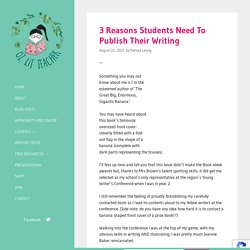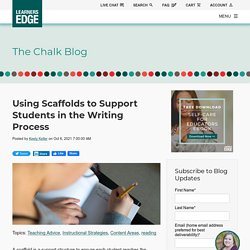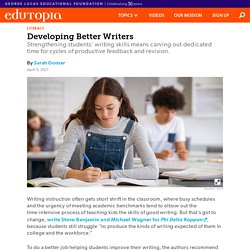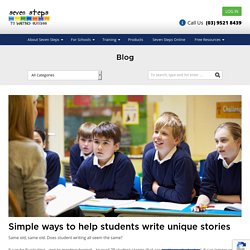Zoom
Trash

A Step-by-Step Plan for Teaching Argumentative Writing. Mentor Texts: The What, Why and Where - Oz Lit Teacher Narissa Leung. We’ve just moved houses and, after living in a rental house with a complete mishmash of furniture (like uni students who haven’t really even grown up), my husband and I have decided to try our hand at living like proper grown-ups by getting ourselves some matching furniture.

Unfortunately, neither of us have any interior design skills so it’s going to be a long and potentially arduous process for us (despite how many episodes of The Block we’ve watched). Our first step has been to seek out examples of styling designs we like. We’ve realised that there are some that float our boat and others that certainly don’t suit our style (I’m looking at you Hollywood Glam). We’ve scoured the internet for room styling photos that we can use to help us craft just the right look in our house. Of course, we could read up on the theory of good interior design, but we really need to see it to have that ‘aha’ moment. In other words, we need someone to “show” us, rather than “tell” us. A mentor. Everyone. 3 reasons students need to publish their writing - Oz Lit Teacher Narissa Leung. Something you may not know about me is I’m the esteemed author of ‘The Great Big, Enormous, Gigantic Banana.’

You may have heard about this book’s famously oversized front cover- cleverly fitted with a fold out flap in the shape of a banana (complete with dark parts representing the bruises). I’ll fess up here and tell you that this book didn’t make the Book Week awards but, thanks to Mrs Brown’s talent spotting skills, it did get me selected as my school’s only representative at the region’s Young Writer’s Conference when I was in year 2. I still remember the feeling of proudly brandishing my carefully contacted book as I read its contents aloud to my fellow writers at the conference. (Side note: do you have any idea how hard it is to contact a banana shaped front cover of a prize book!?) Walking into the conference I was at the top of my game, with my obvious skills in writing AND illustrating, I was pretty much Jeannie Baker reincarnated.
Using Scaffolds to Support Students in the Writing Process. A scaffold is a support structure to ensure each student reaches the learning target and/or completes a task or project that you have assigned to them.

Scaffolds are not only best practice for students with disabilities and/or English learners, but also for each student who needs them. According to Collaborative Classrooms: “Scaffolding in the classroom consists of helpful interactions between the teacher and the student that enable the student to do something beyond what he could do independently.
School Improvement Episode 34: PLCs to improve student writing… Hello, I’m Jo Earp and thanks for downloading this podcast from Teacher magazine.

My guest on today’s episode of School Improvement is Bernadette Hawker, Head of Department Teaching and Learning at Goondiwindi State High School in Queensland. I caught up with Bernie to talk about the school’s award-winning STEAM Program, which has been successful in improving student writing outcomes. You’ll also hear about the strong culture of sharing and collaboration among staff, including through Professional Learning Communities, that’s been key to the program’s continued growth and success. So, let’s get started. Jo Earp: Bernie, welcome to Teacher magazine. Using quality mentor texts to explicitly teach students how to write… Findings from an action research project in three West Australian schools suggest the use of quality mentor texts when explicitly teaching how to write narratives can improve students’ storytelling ability.

Here, Ron Gorman and Dr Sandy Heldsinger share more details about the teaching and assessment strategies used, and samples of student writing. ‘Don’t tell me the moon is shining; show me the glint of light on broken glass.’ Whilst there is some dispute over whether Anton Chekov ever wrote to his brother advising him to describe the ‘glint on the broken glass’, this advice succinctly captures the essential craft of narrative writing.
Action research: Physical activity and student writing. Leah Carter (Assistant Head of English) and Hugo Engele (Director of Co-Curricula) are undertaking a two-year action research project at St Aloysius College, Kirribilli, to investigate the impact of physical activity on student writing ability.

Here, they share the research aims and what has happened so far. The pressure on schools to achieve academic results is ever increasing. Is there a space for physicality and creativity at the centre of our complex, cut-throat and dynamic educational climate? How to Deal with Student Grammar Errors. Developing Better Writers. Writing instruction often gets short shrift in the classroom, where busy schedules and the urgency of meeting academic benchmarks tend to elbow out the time-intensive process of teaching kids the skills of good writing.

But that’s got to change, write Steve Benjamin and Michael Wagner for Phi Delta Kappan, because students still struggle “to produce the kinds of writing expected of them in college and the workforce.” To do a better job helping students improve their writing, the authors recommend adopting an apprenticeship framework. The concept of cognitive apprenticeships—where teachers “model how to do the task, narrating their thinking at every step, and students repeat the process, explaining their actions as they go,”—isn’t new, yet it’s rarely practiced in the classroom, write Benjamin and Wagner, who are, respectively, an education consultant, and the chief academic officer of Concord Community Schools in Indiana. Dig Deeper on Some Assignments Model the Writing Process. Why Students Should Write in All Subjects. For Kyle Pahigian, a 10th-grade math teacher at University Park Campus School in Massachusetts, a lesson on congruent triangles doesn’t start with calculators and protractors.

Instead, she hands her students a treasure map and asks them to write detailed directions—using landmarks as a guide—to the buried treasure. “I won’t tell the kids right away, ‘Today we’re going to learn about triangle congruence theorems,’” said Pahigian. “I want them to instead view it as them experimenting with something and doing something that they feel like they’re really good at.” Students often feel intimidated by math, and transforming the activity into a writing exercise eases some of the anxiety of introducing difficult concepts, she said.
Why Students Should Write in All Subjects. A Step-by-Step Plan for Teaching Narrative Writing « Cult of Pedagogy. Simple ways to help students write unique stories. Same old, same old.

Does student writing all seem the same? It can be frustrating – not to mention boring! – to read 20 student stories that are pretty much identical. It can trigger real disappointment when you know there’s the potential for unique writing from each student. “Argh! Improving student writing skills. South Australian primary school teacher Bec Drozdoff faced a challenge in her writing lessons.

She had students with a great capacity to speak and hold conversations using a wide range of vocabulary, but, when it came to writing, they could stare at their blank page for 20 minutes without writing anything at all. ‘How quick we are as teachers to put our students on the spot to write a complete narrative piece and wonder why we are constantly plagued with “I can't think!” ,’ the Year 3 teacher at Southern Vales Christian College says. Writing needs to be taught and practised. Australian schools are dropping the focus too early. The recently released report of the NAPLAN review — commissioned by the New South Wales, Queensland, Victorian and Australian Capital Territory education ministers — found many young people are reaching Year 9 without being able to write properly.
The number of students below the national minimum standard is higher in regional and remote areas. Pre-service teachers and creative writing. At the Art Gallery of Ballarat, a group of secondary school students, pre-service teachers (PSTs) and English teachers spend two-and-a-half days writing together in order to encourage creativity and improve students’ writing skills. It’s all a part of a program called Artful Writing, which was developed by Amanda McGraw, the Master of Teaching Coordinator at Federation University Australia, with the support of Kate Gorman, education officer at the gallery.
The collaboration between the gallery and Federation University Australia saw the first Artful Writing program held in 2018. Writing exercise: What changes the future? - Scottish Book Trust. Every day we cast ourselves into the future, imagining what’s next in our lives. For many of us, the future represents opportunity and gives us hope that we can make positive change for our loved ones, our communities or ourselves. Warm up exercise: word bank At the top of your piece of paper or document, write the words past, present and future in three columns. Spend a few minutes adding whatever words come to mind under each column. Storyathon - Let's Write Microstories!
'I'm in another world': writing without rules lets kids find their voice, just like professional authors. Ask a child why they write and you might receive a common response: the teacher told me to. Kids often lack confidence as writers and find it emotionally draining. The problem might be the classroom and its detachment from what writers do in the real world. MAKING (and writing) a Personal Narrative: Scaling Print Barriers and Building Stamina. This week, I had the opportunity to make and write personal narratives with writers and teachers from Fieldstone Middle School in North Rockland, New York.
And I thought I’d share that process with you, so that you may iterate on it and share your own ideas and work back with the rest of us. We’ve been talking about narrative writing all month in my Facebook group, Building Better Writers, and I know that at least a few people there are hoping that I’ll share enough of the week behind me to help them begin this work themselves. I also know that some of the teachers that I supported in North Rockland might like a narrative of the plan that they can return to. A Step-by-Step Plan for Teaching Narrative Writing. Inspire Your Students with These 351 Visual Writing Prompts - Nick's Picks For Educational Technology. Strategize: Great Ideas for Library Writing Programs.
Illustration by Leigh Wells Kelly Menzel is never quite sure what to expect when the teens in her writing club at the North Tonawanda (NY) Public Library participate in a “round robin” writing activity. One time a story about Sherlock Holmes ended up with the fictional sleuth embarking on a date with Shrek along the French Riviera. In due course, however, they pass their notebooks around and add to each other’s sentences, even the boys who originally showed up at the gatherings for the free food are contributing to the final product. How to Deal with Student Grammar Errors. How To: Create an Interactive E-Book with Google Slides. The Digital Writing Process. Dr. PDF aux Flash - création de catalogues interactifs. Ourboox - Create picture books online. Essay Map. 15 Awesome Ways To Use Blogs in Your Classrooms.
Rhetorical Devices in Sound. Introductions - The Writing Center. Inklewriter. Igniting Student Writer Voice With Writing Process Strategies. A teacher taught a lesson on telling a Six-Word Story. There are websites that provide examples of this writing style. On the surface, the task appears simple, but it's quite challenging when you dig into it. The students seemed intrigued by the idea of composing these stories, until the teacher said with enthusiasm, "Let's get writing. " One student immediately asked questions that the teacher grappled to answer. Two boys stared at their blank page.